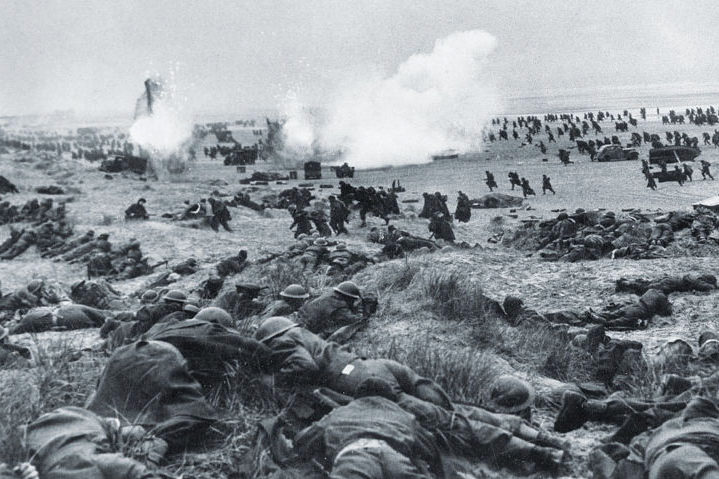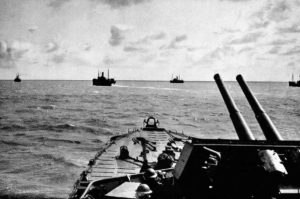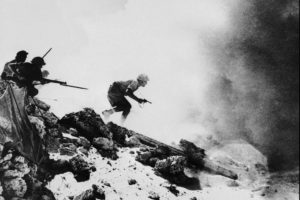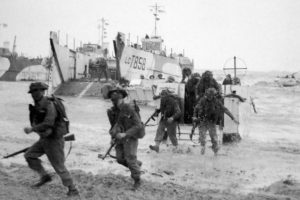(10th May 1940 – 25th June 1940)
Dunkirk is viewed by the British mostly as a triumph. But it was born from the disaster of The Battle of France which covers the German invasion and defeat of France, Belgium, the Netherlands and Luxembourg.
It took Germany, starting on 10th May 1940 which was the same day as Churchill became Prime Minister, just six weeks to conquer four countries and drive a fifth, the United Kingdom, from continental Europe. In this short period Germany accomplished what they had failed to achieve in four years during the First World War.
With Germany’s re-worked Schlieffen Plan, France’s ineptitude and Britain’s lack of preparation for war, this was an easy victory for Hitler. This Battle includes Italy’s invasion of France over the Alps on the 10th June 1940 and Britain’s evacuation at Dunkirk.
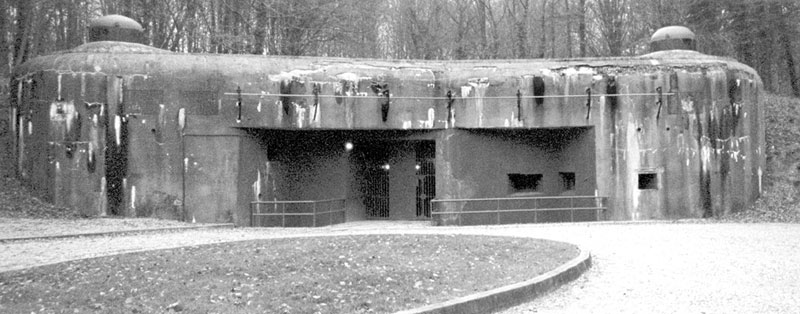
A French Fortress on the Maginot Line
Background to the Battle
In 1940 France had an army comparable in size to Germany but it was an army that had not learnt the lessons of the First World War. It was an army that had been on the winning side and was now complacent about its military tactics. It was an army that had been on the side that had created both tank and plane warfare but it had done nothing since to develop either. It was an army that had reverted to relying upon trains and horses, particularly horses, in what was now a more modern world.
Meanwhile Britain, after the First World War, had in typical British fashion, reduced its army to a mere rump. It was now struggling to meet its obligations for the coming battle even though these requirements were a mere fraction of those of France. Britain had committed to providing a full strength army of three corps containing 3 divisions each plus a reserve or HQ Division. They struggled to supply this but nevertheless showed plenty of fortitude (unlike many of their French counterparts) when their numbers were tiny in comparison to the enemy they had to face and when their equipment was vastly inferior as a result of years of under funding.
France had suffered a great loss of life during the First World War; more so than any other country. This had affected its military thinking which had become almost entirely defensive and it had forgotten the maxim of one of its greatest Generals, Napoleon that the best form of defence is often attack.
France was also politically torn between rival factions creating political and civilian unrest. For over ten years there had been an endless churn of new governments. Barely any of them lasted a full year in power. The right and the left were so opposed to each other that in 1934 Marshal Petain, the great French General of the First World War who was now approaching 80, was invited to join a government of national unity in an effort to bring some stability to French politics. But still the opposing factions were more interested in defeating each other than uniting to fight a common foe.
By now France was sheltering behind its Maginot Line, a line of concrete fortifications, obstacles, and weapon installations. Stretching from Switzerland to Luxembourg along the 87 mile Franco–German border, it was manned by half a million French soldiers and created, as the French thought, an impassable barrier to any German aggression. This defensive line had taken 10 years to complete and was only finished in 1938.
However, when in 1936 Belgium declared itself a neutral country and closed its border to its former French ally, France realised, too late, that they had a 250 mile border from Luxembourg to the North Sea that was now undefended. However good the Maginot Line might have been, it was going to be of little use if the Germans did not come that way.
Meanwhile just a few years earlier in Germany, a rising German Officer called Heinz Guderian had published a book called Achtung Panzer. In this book he advocated a joined up form of warfare that included a concentrated use of tanks and infantry supported by the air force. It was to be become known as Blitzkrieg.
Based on the German principles of manoeuvre warfare to which Blitzkrieg had now been added, General Gerd von Rundstedt, much to Hitler’s approval, reworked the Schlieffen Plan. He aimed to create a breakthrough and encirclement, and in this way destroy the main body of Allied forces.
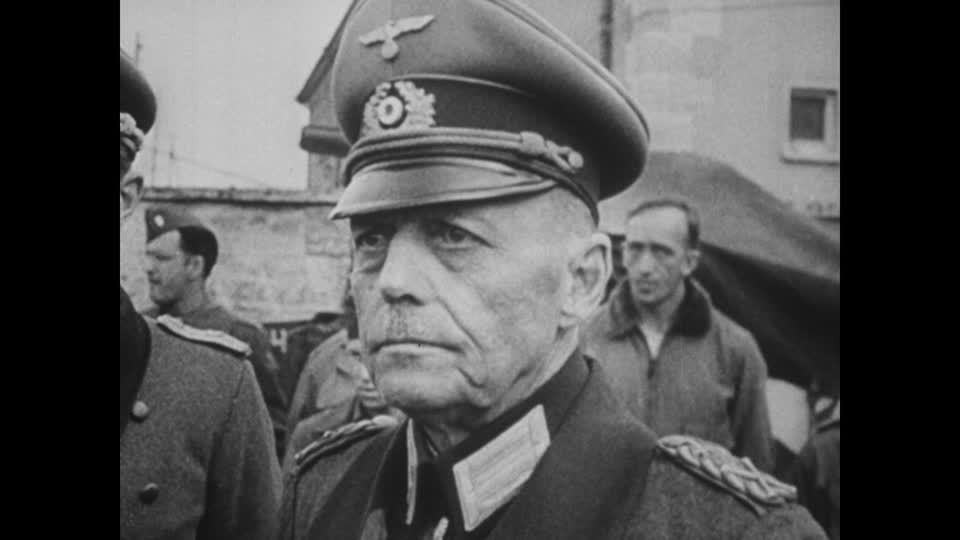
General Gerd von Runstedt – arguably Germany’s most able Field Commander in World War II was brought out of retirement to fight the War.
The Phoney War
Commanding the allied armies in France in 1939-40 was Maurice Gamelin, the head of the French army. He was a remote and somewhat uninspiring General who owed his position to being the perfect choice of politicians with whom he would never dissent.
He chose for the Allied Headquarters Château de Vincennes on the outskirts of the east of Paris. This enormous building was an old royal fortress which hardly lent itself to the modernity of 20th century warfare. It had no external radio or telephone communications and all orders had to be sent and received via dispatch riders. Gamelin and his senior Generals remained largely ensconced within for the duration of the Phoney War and during much of the battle itself. They made scant attempts to visit their troops or even their subordinate commanders on the frontline.
A feeling of remoteness and detachment pervaded the French army. Their morale during the cold winter of 1939/40, the period known as the Phoney War, plummeted with drunkenness, racketeering and absenteeism all prevalent.
The British did not suffer from poor morale. Their problem was finding enough troops to make up the 10 Divisions they had promised. After initially providing just two Corps, the British managed to increase their numbers and by the time the Battle of France commenced they had managed to create a third Corps. However the criticism remained that the BEF had to rely upon too higher a proportion of territorial (part-time) troops due to a shortage of regular fully trained soldiers.
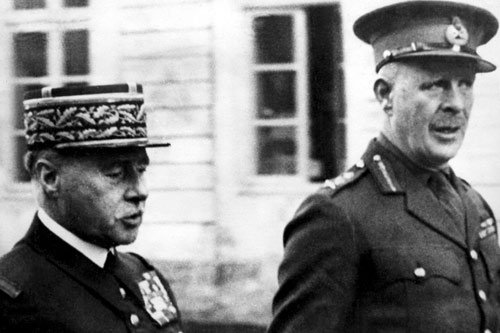
Lord Gort (on the right) commander of the BEF with the Commander-in-chief, French General Maurice Gamelin.
Under his command Gamelin had 100 French Divisions plus the 10 British divisions. His plan was for 40 French Divisions to occupy the Maginot Line plus a further 5 to guard the Swiss border. His best 40 French Divisions, plus the ten from Britain, were ordered by him to dig in along the Belgium border. However, whilst doing this, they were made aware that when the Germans attacked they would be required to advance into Belgium.
He kept 15 divisions in reserve and placed his 10 weakest and least well equipped Divisions along the border with the Ardennes Forest. But, by planning to move his best troops into Belgium once the action started, the Ardennes sector would become a vital pivot point in the line; yet he left it in the hands of his weakest troops. The German Generals were more than aware of this and aimed to exploit this weak deployment.
Gamelin’s long-term strategy during this period was not to attack Germany even though both Britain and France had declared war on Germany in order to come to the aid of Poland. In this respect, Gamelin’s Allied army did nothing. His non-aggressive policy was supported by a French government that wished to avoid fighting on French soil and a British government that was still controlled by appeasers in the form of Neville Chamberlain as Prime Minister and Lord Halifax as Foreign Secretary.
Gamelin claimed that he wanted to wait until France had fully rearmed and for the British and French armies to build up their forces before confronting the Germans. This, in reality, would have meant waiting until 1941. He even prohibited any attacks on German soldiers or any bombing of the industrial areas of the Ruhr in case the Germans retaliated. For this he has since been particularly criticised for the period during the early part of the Phoney War when the German army was deployed in Poland and there were very few troops guarding Germany’s western frontier.
The Battle
At 5.30am on 10th May 1940, the same day that Winston Churchill became British Prime Minister, Germany’s Army Group B invaded the neutral Netherlands. At the same time the Luftwaffe attacked 50 British and French airfields destroying numerous allied planes that were still on the ground. Gamelin immediately moved his best 40 divisions plus the 10 British divisions into Belgium and straight into the trap that had been set for him.
While the 20, or so, Divisions of German Army Group B was attacking the Dutch, the 46 Divisions of German Army Group A under the command of General von Rundstedt were making their way through the Ardennes Forest undetected by the allies. Within three days they had reached the border at Sedan on the River Meuse. They found all the bridges across the river had been blown up by the French. However 40 miles to the north of Sedan the French had left one weir intact for fear of lowering the river level and thus making a river crossing easier for the Germans. Typically, the French had left the weir undefended so a Panzer Division pounced and used it to cross the river. This Division was commanded by none other than General Erwin Rommel.
Gamelin was now in denial. More concerned about what was happening in Belgium and the Netherlands, he refused to believe that the Germans had already reached Sedan. He failed to reinforce the weak French Divisions holding the line there and they, in turn, failed to put up much resistance for fear of running out of ammunition.
With Rommel across the river and establishing a bridgehead it was not long before German sappers were bridging the river and preparing to bring the remainder of the army across. The next day, allied air forces attempted to attack these bridges but with dire results. Nearly half the planes that took part in the raids that day were lost. In the words of the official RAF history, “No higher rate of loss has ever been experienced by the RAF”. Now, the skies were entirely in the control of the Germans.
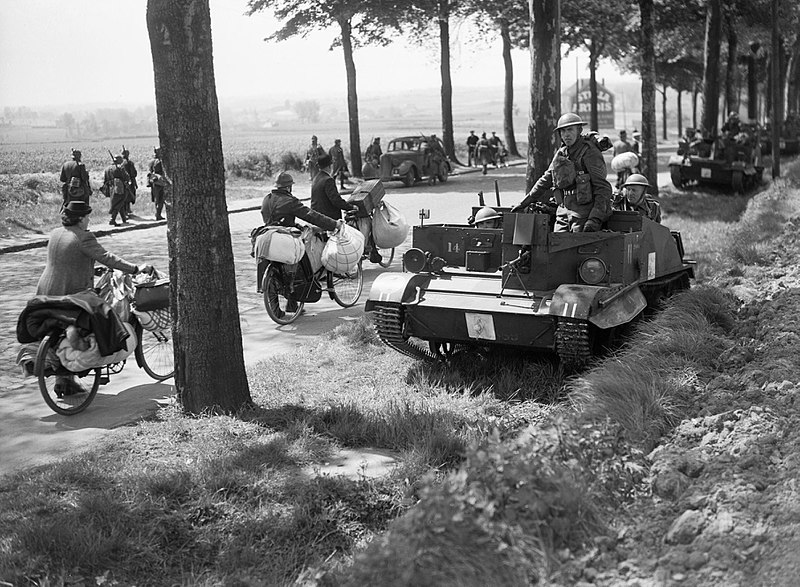
British Bren Gun Carriers moving forward in Belgium pass Refugees fleeing from the Germans
Even before the French and British troops in Belgium had fully engaged the enemy, the battle was already lost. They were trapped. To their north was German Army Group B mopping up the last of the Dutch resistance before turning south. To their east and south was German Army Group A. They were about to be completely surrounded on three sides with only the North Sea behind.
The French Generals, thinking that the Germans would strike for Paris from Sedan pulled their troops back from the Ardennes region to protect the capital. This only widened the gap in the allies’ defensive line through which the Germans now sped in the direction of the English Channel to complete the encirclement of the main Franco-British army in Belgium.
Refusing to accept that his tactics were at fault, Gamelin sacked twenty of his most senior generals. By the seventh day of the battle, the Netherlands had already surrendered and Brussels was captured. With panic in Paris, Paul Reynaud, the French Prime Minister dismissed Gamelin and replaced him with the 73 year old General Maxime Weygand who was brought out of retirement. Three days later, on the 20th May, the Germans reached the English Channel south of Boulogne and the phone lines between London and Paris were cut.
Dunkirk
The British Expeditionary Force (BEF), commanded by Lord Gort, had advanced, as ordered by Gamelin, to a new position along the River Dyle. Here they encountered elements of the German Army Group B. But within days they received orders to withdraw to the Scheldt River when the Belgian and French positions on their flanks failed to hold.
It was on the 19th May when Gort met with the French General Gaston Billotte, commander of the French First Army, that he was informed that the Germans had nearly reached the English Channel and that France now had no troops between the Germans and sea. Immediately, Gort realised that his best course of action was to evacuate the BEF across the channel and he began planning a withdrawal to Dunkirk, the closest port with good facilities for embarkation.
What was also going to prove important was that Dunkirk is surrounded by marshes and dykes; it has old fortifications all of which would be useful for fighting a rear-guard action. And Dunkirk has the longest sand beach in Europe, where large groups can be assembled.
Without informing the French, the British began planning their evacuation on the 20th May under the codename Operation Dynamo. The planning was headed by Vice Admiral Bertram Ramsay at the naval headquarters below Dover Castle. On Churchill’s suggestion, the Admiralty also began arranging for all available small vessels to be made ready to go to France.
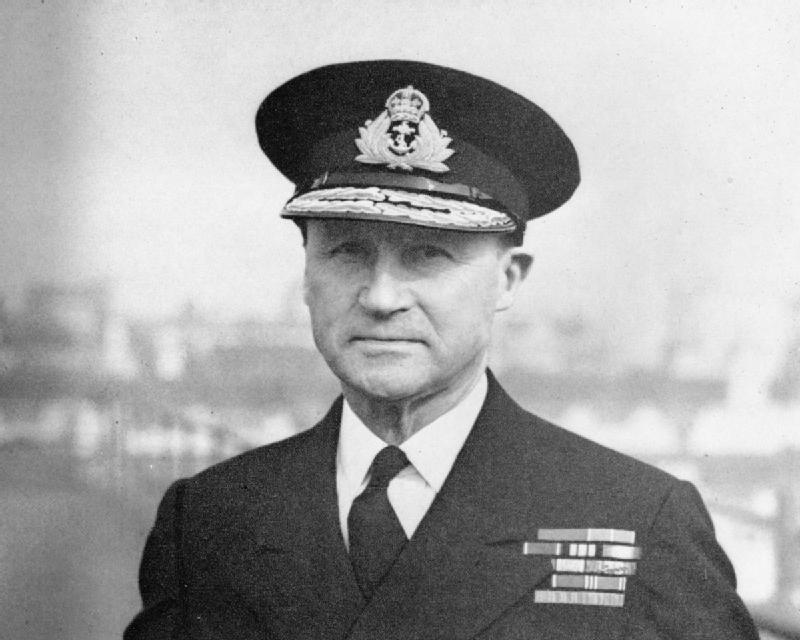
Admiral Bertram Ramsay organised the Evacuation from Dunkirk.
The next day the British together with elements of the French army and the remains of the Belgium army made a final attempt to cut through the German spearhead at Arras. Its failure confirmed that the BEF was trapped in northern France and Belgium.
Churchill still wanted the BEF to make another attempt to cut through the German spearhead but on the 25th May Gort abandoned any hope of achieving this objective and withdrew the BEF towards Dunkirk on his own initiative.
He was joined by the French First Army now under the command of General Georges Blanchard following Billotte’s fatal road accident two days earlier. Together they pulled back behind the Lys Canal (part of a canal system that reaches the sea at Gravelines) where the sluice gates were opened to create a barrier against a German advance.
By now the Germans had captured Boulogne and had surrounded Calais. This left Dunkirk as the only port still open to the BEF. Von Rundstedt had also ordered his Panzer units to halt because of concern about their vulnerable flanks and a shortage of supplies for the forward troops. He was also concerned that the marshy ground around Dunkirk would be unsuitable for tanks and he wished to conserve them for the main objective – the conquest of France. He therefore decided to wait for both the infantry and supplies to catch up. His decision was endorsed by Hitler.
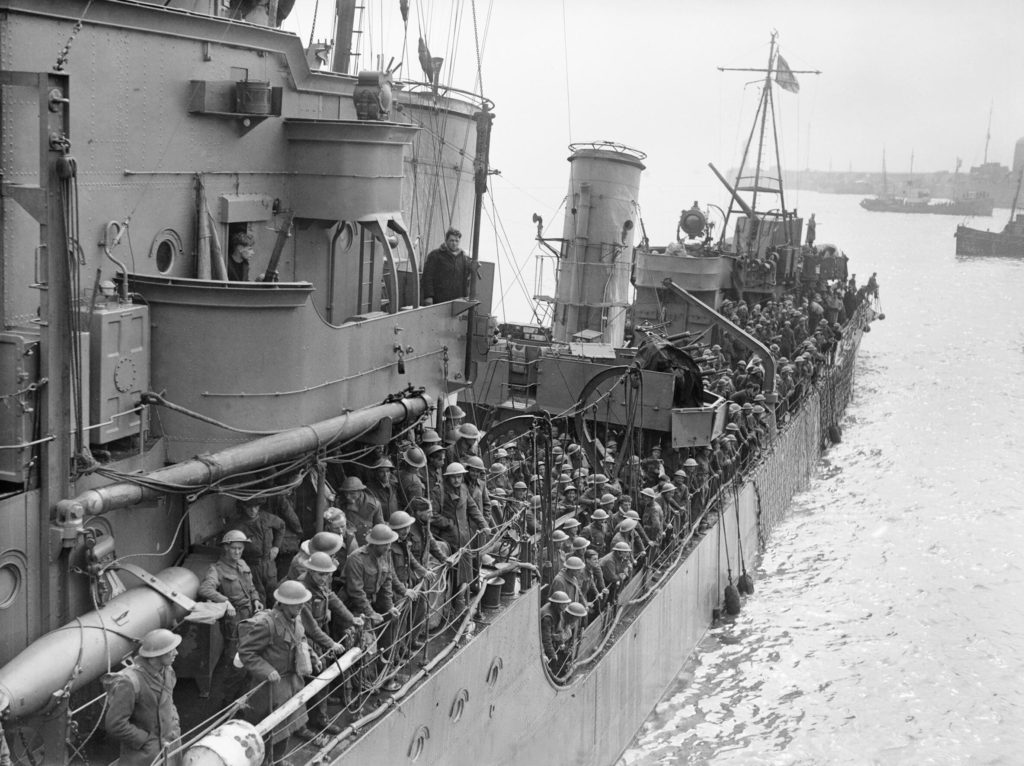
British Troops arriving back at Dover.
The main evacuation of British troops from Dunkirk started on the 27th May. At this stage the majority of the evacuation was taking place from the docks but the whole area was being heavily bombed by the Luftwaffe who in turn came under attack from 16 squadrons of the RAF who claimed 38 kills that day for the loss of 14 aircraft. Throughout the entire operation, the RAF took a heavy toll on the German bombers.
Over 3,500 sorties were flown by the RAF in support of Operation Dynamo mainly by fighters of 11 Group under the command of Air Vice Marshall Keith Park. But the RAF could not prevent the Luftwaffe from damaging the port with the result that the evacuation had to be switched to the beeches where it took much longer to embark troops.
Many soldiers, who were bombed and strafed while awaiting evacuation, claimed that the RAF had failed to protect them. This was because they were unaware of the dogfights that took place, often far from the beaches.
Lord Gort, the army commander, was evacuated on the 31st May leaving in command General Harold Alexander, a soldier known for his calmness under fire. (He would be the last British soldier to be taken off the Beaches of Dunkirk.) Meanwhile, the two principle corps commanders had already left for England. Churchill, as the new Prime Minister, was reorganising the senior positions in the army and General John Dill (commander of One Corps) had been withdrawn to become Head of the British Army (Chief of the Imperial General Staff) and General Alan Brooke (commander of Two Corps) had been recalled to take over command of Homeland Defence.
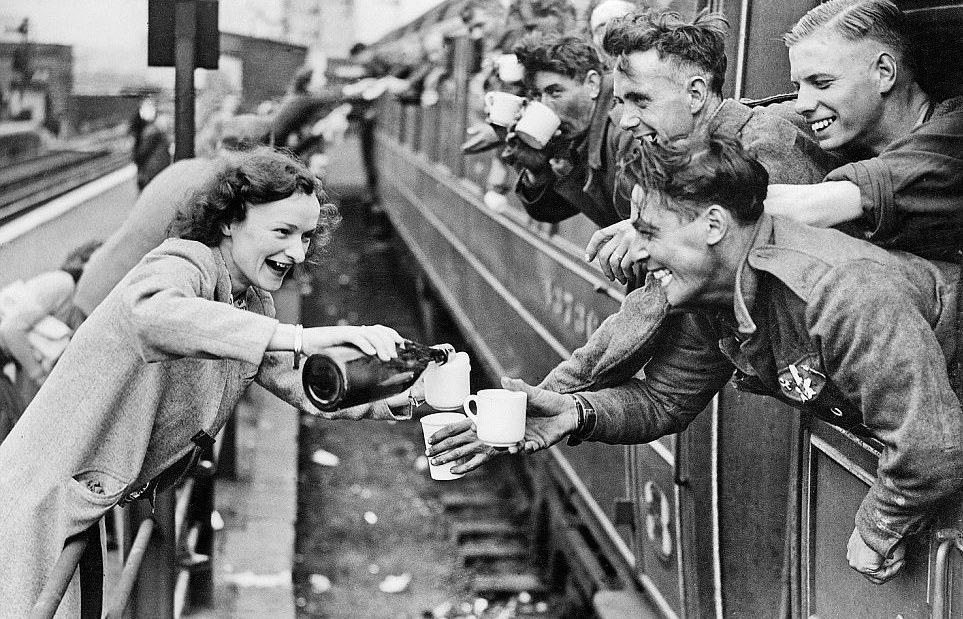
British Troops receive a Warm Welcome back in Blighty
By the 1st June the majority of the BEF had been evacuated from Dunkirk plus around 40,000 French troops. An increase in air attacks by the Luftwaffe was now making daylight evacuation more difficult but the last 4,000 men of the British rear-guard managed to get away on the night of 2nd/3rd June and an additional 75,000 French troops left over the last three nights. The operation finally ended on the 4th June with the remainder of the rear-guard of 40,000 French troops surrendering having stayed in position to let the others get away.
On that day Churchill made his famous “We shall fight on the beaches” speech to Parliament. He paid tribute to all the armed services and to the little ships. He also made the point that the evacuation had only been made possible through the efforts of the RAF.
In total 338,226 troops (including 120,000 French soldiers) withdrew across the English Channel during the Dunkirk evacuation. Having halted his panzers and effectively allowed the British to get away, General von Rundstedt would after the war describe the event as, “One of the great turning points of the war”.
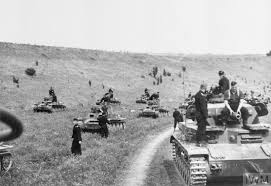
Rommel’s Tanks – Heading for Paris having crossed the River Somme (June 1940)
The Fall of France
After Britain’s successful evacuation from Dunkirk and its capture by the Germans, Paris and the remainder of France fell quickly to the German army. The French were now severely outnumbered. Whole divisions had been captured and lost in Belgium; the British had escaped to blighty; and France had 40 Divisions trapped in the Maginot Line who were now being attacked from the rear. Despite this, the France army did fight more stoically under Weygand but it was a forlorn attempt.
Within three days of the fall of Dunkirk, Rommel’s men reached Rouen on the River Seine. That same day Italy, who had previously been offering to broker a peace deal between Britain and Germany, declared war on both Britain and France and invaded France in the south. Two days later Paris fell. Marshal Petain, now acting as Prime Minister following the resignation of Paul Reynaud asked the Germans for an Armistice.
The Battle of France was over and the French had been crushed and would remain under German occupation for the next four years.
“What General Weygand has called The Battle of France is now over. The Battle of Britain is about to begin.”
– Winston Churchill

